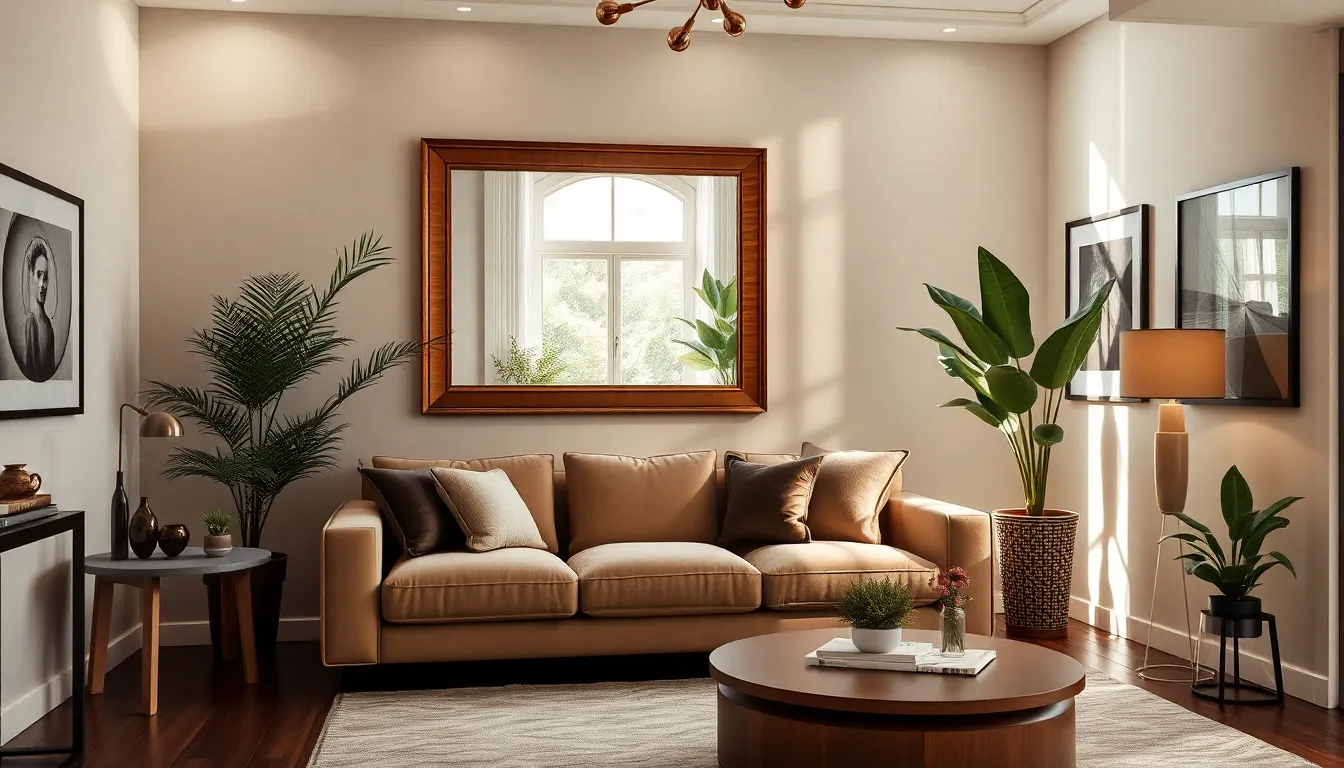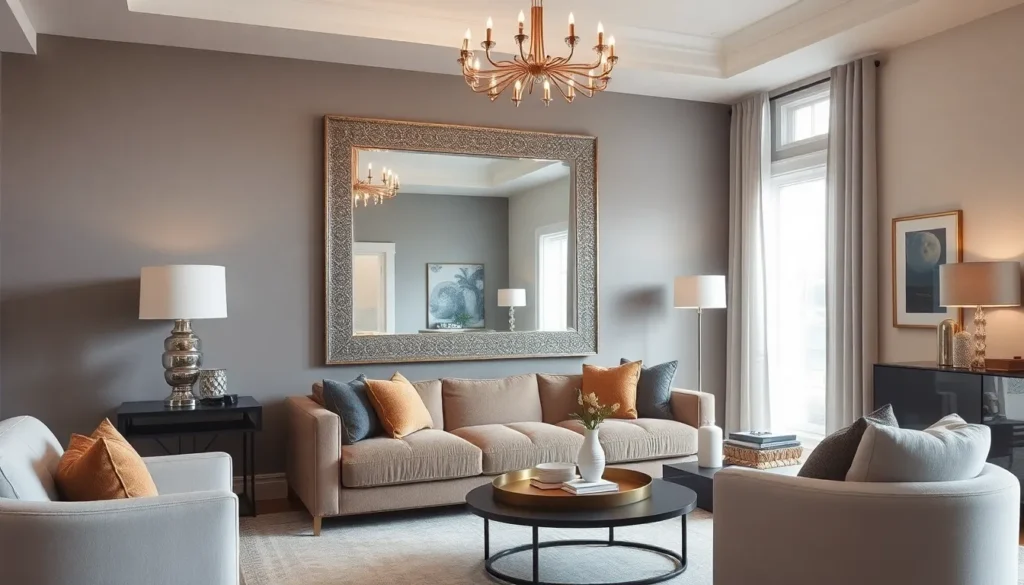Wall mirrors do more than just reflect images; they transform spaces, making rooms feel larger and brighter. The right placement can enhance the aesthetic appeal of any area, creating a sense of balance and harmony. Whether it’s a small bathroom or a grand living room, understanding how to position mirrors effectively is key to maximizing their impact.
Strategic mirror placement can also influence the flow of energy within a space. By harnessing natural light and directing it where it’s needed most, mirrors can elevate the overall ambiance. This article explores essential tips and tricks for optimal wall mirror placement, ensuring every reflection serves both functional and decorative purposes.
Table of Contents
ToggleImportance Of Wall Mirror Placement
Wall mirror placement significantly impacts the aesthetics and functionality of a space. Properly positioned mirrors can enhance the perceived size of a room by reflecting light and creating visual depth. In spaces that lack natural light, mirrors direct available lighting, thus brightening dark corners and elevating the room’s overall ambiance.
Strategic placement encourages balance and harmony within a room. For instance, placing mirrors across from windows or light sources maximizes sunlight reflection, improving energy flow. Additionally, mirrors act as focal points, drawing attention to specific areas or features within a space, such as artwork or elegant furniture.
Moreover, mirrors can serve practical purposes, such as providing a functional surface for grooming in entranceways or bathrooms. Mirrored surfaces can create illusions of heightened ceilings or wider corridors, which may be necessary in compact living areas.
Incorporating mirrors thoughtfully ensures that they not only complement decor but also contribute to the overall design narrative, enhancing style while fulfilling practical requirements.
Best Locations For Wall Mirrors

Strategic wall mirror placement enhances both aesthetic appeal and functionality in various spaces. Here are optimal locations for mirror installation.
Living Room Placement
- Above the Sofa: Position mirrors directly above sofas to create a balanced focal point and reflect light.
- Opposite Windows: Place mirrors across from windows to maximize natural light and make the room feel larger.
- Gallery Walls: Incorporate mirrors in gallery wall arrangements to add depth and contrast with artwork.
- Corner Areas: Use mirrors in corner spaces to eliminate shadows and create an illusion of more expansive dimensions.
Bedroom Placement
- Above Dressers: Install mirrors above dressers for grooming and styling, ensuring functionality and elegance.
- Near Closet Doors: Position full-length mirrors by closet doors for dressing purposes, enhancing practicality in limited spaces.
- Accent Walls: Create a stunning accent wall with multiple mirrors to add visual interest and depth.
- Bedside Table Reflection: Use smaller mirrors on bedside tables to reflect soft lighting, contributing to a cozy atmosphere.
Entryway Placement
- Over Console Tables: Hang mirrors above console tables to provide a quick reflection before leaving and to visually expand the entrance.
- Near Front Doors: Place mirrors adjacent to front doors for utility and to brighten the space as guests enter.
- Hallway Mirrors: Position mirrors in narrow hallways to create a sense of openness and enhance the flow of space.
- Accent Lighting Reflections: Use mirrors to reflect entryway lighting, adding warmth and inviting ambiance to the space.
Factors To Consider For Wall Mirror Placement
Consider various factors when placing wall mirrors to maximize their impact and functionality. Proper attention to size, scale, height, and angle enhances both aesthetics and utility.
Size And Scale
Choose a mirror size that complements the surrounding space. Large mirrors suit expansive walls, creating a dramatic effect, while smaller mirrors work best in tighter areas. Scale the mirror to furniture size; for instance, a mirror above a sofa should be two-thirds the width of the sofa for balance. Additionally, consider the dimensions of neighboring objects—large mirrors against small furniture can dominate the visual space, while overly small mirrors may get lost in larger rooms.
Height And Angle
Position mirrors at eye level for optimal usability. Installing the mirror 57 to 65 inches from the floor typically accommodates most average heights. Adjust the angle to reflect desired views, like gardens or artwork. A slight tilt can enhance light reflection and add dimension to your space. Experiment with different heights and angles to find the arrangement that best suits the room layout and purpose.
Tips For Creative Wall Mirror Placement
- Enhance lighting: Place mirrors across from windows to maximize natural light, allowing reflection to brighten the room effectively.
- Create depth: Use mirrors to add dimension in small spaces. Hanging them in narrow areas can visually extend the room, making it feel larger.
- Utilize focal points: Position mirrors to highlight art pieces, statement furniture, or architectural details, directing attention to the most striking aspects of the space.
- Experiment with styles: Mix various mirror shapes and frames to create an eclectic display. Circular mirrors paired with rectangular ones can add visual interest.
- Incorporate different heights: Arrange mirrors at varying heights on gallery walls. This approach adds complexity and curates an engaging visual flow.
- Reflect surroundings: Consider placing mirrors to capture and reflect appealing views, such as beautifully landscaped gardens or expansive cityscapes.
- Enhance function in practical areas: Attach mirrors in bathrooms or dressing rooms where functionality meets style, providing utility while elevating the aesthetic.
- Use in entryways: Hang mirrors near front doors to create a welcoming atmosphere. They can serve as both functional items for last-minute adjustments and beautiful decorative pieces.
- Frame with lighting: Use wall-mounted spotlights or sconces to illuminate mirrors. This technique enhances their reflective qualities and highlights the room’s decor.
- Complement design themes: Choose mirrors that align with the overall design theme, ensuring they harmonize with existing decor elements, color schemes, and textures.
Wall mirrors are more than just reflective surfaces; they’re powerful design tools that can elevate any space. By thoughtfully considering placement and style, one can create an inviting atmosphere that maximizes light and space. Whether enhancing a cozy bedroom or brightening a narrow hallway, mirrors can transform the overall aesthetic.
Experimenting with different sizes and arrangements allows for unique displays that reflect personal style. With careful attention to detail, mirrors can seamlessly blend functionality with beauty, making them essential elements in any interior design scheme. Embrace the potential of wall mirrors to redefine your living spaces and enjoy the benefits they bring.



